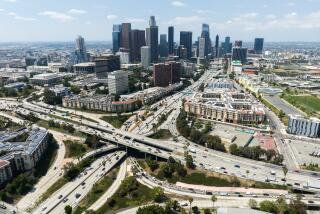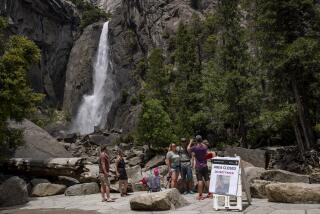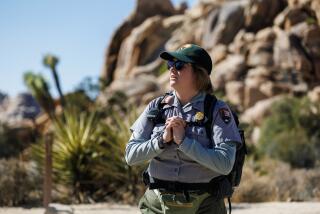Timetable Set for National Park Transit Plan
- Share via
WASHINGTON — The Clinton administration Tuesday announced a timetable for eliminating most car traffic from three of the nation’s busiest national parks and creating regional public transit systems.
By the year 2000, day-use automobile traffic would be prohibited at Grand Canyon in northern Arizona. The following year similar bans would take effect in Yosemite and Zion in southern Utah.
Assuming the proposed public transit systems are in place, most people would leave their cars in outlying communities and ride buses and light rail cars into the parks. Only overnight visitors would be able to drive their cars inside the parks.
The administration’s transportation strategy, announced by Interior Secretary Bruce Babbitt, dovetails with a recently released Yosemite Valley master plan designed to reduce crowding by cutting back on cars, roads, parking lots, hotel rooms, campgrounds, employee lodging, offices and commercial structures.
A contingency plan, however, calls for the construction of a new parking lot at the west end of the valley to accommodate up to 1,800 day-use vehicles in the event the regional transit system is not in place by 2001.
Jerry Mitchell, chief of management plan implementation at Yosemite, said the main significance of the administration’s strategy is to bring representatives of the U.S. Department of Transportation into the process of designing regional transportation systems at the three parks.
“The five adjacent counties will continue to be in charge of the planning, but the addition of the Department of Transportation will add expertise that the Park Service could not provide,” Mitchell said.
In announcing the administration’s plans, Babbitt said the changes at the three parks will be considered a blueprint for other national parks, such as Acadia in Maine and Golden Gate in San Francisco. The intent is to limit the number of cars, not people, to make visits more enjoyable.
“The problem isn’t too many people, it’s too many cars,” he said of the crowding in many major national parks.
A summer morning in Yosemite, Babbitt said, has become a bit like Times Square because of the crowds.
Along the South Rim of the Grand Canyon, the sound of the wind in the pine trees has been replaced by the rumble of engines and the scent of fumes, Babbitt said. So autos will be banned from that road, and parking lots will be built outside the park.
Light rail lines will run 24 hours a day, 365 days a year, Babbitt said, carrying up to 4,000 visitors an hour to a new visitor center. The center will be built at a cost of $13 million to $14 million, he said, using funds from park entry fees. Those fees will probably not increase, he added.
The department is looking for a private developer to build the light-rail system, estimated to cost $67 million. The contractor would receive a percentage of each park entry fee, Babbitt said.
The plan for Zion also calls for a ban on cars, with shuttles bringing visitors from nearby Springdale.
Babbitt and Transportation Secretary Rodney Slater signed a memorandum for their departments to cooperate in the development of mass-transit systems for the parks.
“It is time for us to build a transit system for the 21st century that allows us to spend more time sighting bears than looking for a parking spot,” Slater said.
More to Read
Sign up for Essential California
The most important California stories and recommendations in your inbox every morning.
You may occasionally receive promotional content from the Los Angeles Times.










